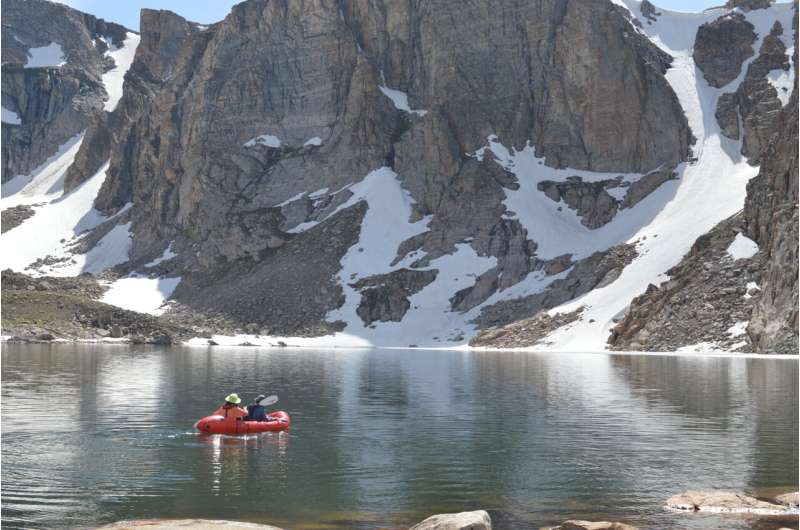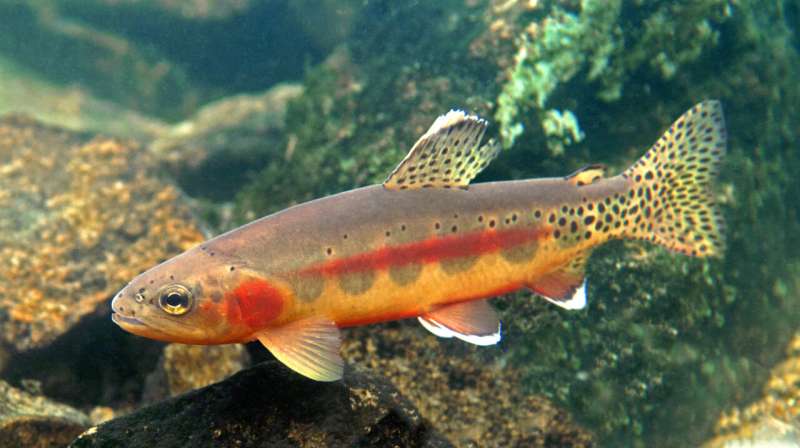This article has been reviewed according to Science X's editorial process and policies. Editors have highlighted the following attributes while ensuring the content's credibility:
fact-checked
peer-reviewed publication
trusted source
proofread
Researchers find evolutionary adaption in trout of Wyoming's Wind River Mountains

The lakes in Wyoming's Wind River Mountains historically didn't contain fish, but stocking of trout that began in the early 1900s has created an environment in which hundreds of those lakes now have strong fish populations—some carried on by natural reproduction for decades.
This environment also has provided a laboratory for researchers to study the ecosystem changes in the once-fishless alpine lakes, to which anglers today make long hikes to pursue cutthroat trout and relatively rare golden trout.
Previous research found that the introduction of fish in the lakes of the Wind Rivers has driven a decrease in the size of zooplankton, the small aquatic organisms on which the trout feed. Now, University of Wyoming researchers have found that the fish themselves have adapted to their environment—"rapid evolution" that sheds further light on the introduction of invasive species.
"These findings have important implications for understanding the capacity of even small founding populations to respond to novel ecological and evolutionary pressures in the face of rapid environmental changes," the UW researchers wrote in a paper published in the journal Evolution.
During the summers of 2018-2021, the researchers collected fish from 18 lakes in the Wind Rivers previously stocked with Yellowstone cutthroat trout, which come from northwest Wyoming, and golden trout, which come originally from the Kern River drainage in California but were first stocked in the Wind Rivers in the early 1900s. The lakes included fish populations that were started decades ago as well as more recently stocked populations. The researchers then compared the fish of the Wind Rivers with golden and cutthroat trout produced in Wyoming Game and Fish Department hatcheries.
The researchers found that the trout from lakes stocked decades ago in the Wind Rivers have higher numbers of gill rakers, which are bony or cartilage structures in the gullets of fish that act as sieves to retain zooplankton and nourish the trout. The scientists say the difference is likely a result of the trout adapting to the food sources of the high-mountain lakes—a change that has taken place in a relatively short period of time and at a rate that is generally consistent with the historic timing of stocking for each of the lakes.

The findings are "evidence that eco-evolutionary interactions play a critical role in ecosystem ecology," the researchers wrote.
"Our observations provide insight into the pattern and timing of adaptive change that follows from (human) interference and … informs our understanding of the role that evolution may play in facilitating adaptation to dynamic, resource-poor environments," they concluded.
The UW team's work in the Wind River Range's alpine lakes is ongoing, with this first paper answering some questions—but raising many more—about the ecology and evolution of organisms in these environments. Ongoing work focuses on examining details of the changes in zooplankton communities with fish introduction, as well as using genetics to identify the source populations from which cutthroat trout were stocked in the Winds.
With connections to UW's WyACT: Wyoming Anticipating Climate Transitions project, the scientists' work also looks at the ways climate-driven changes may affect the ecology and evolution of alpine lake ecosystems.
"The alpine lakes of the Winds are a true treasure of Wyoming," Wagner says. "It's a privilege and a thrill to be able to work in these beautiful places—and to gain a better understanding of the ecological and evolutionary processes that make them what they are today."
More information: Lucia L Combrink et al, Parallel shifts in trout feeding morphology suggest rapid adaptation to alpine lake environments, Evolution (2023). DOI: 10.1093/evolut/qpad059
Journal information: Evolution
Provided by University of Wyoming


















